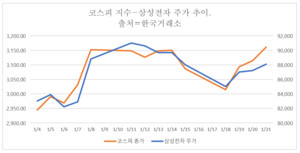[이코노믹리뷰=정다희 기자] The KOSPI index hit a new high. Samsung Electronics (005930), which had been weak throughout the day, rose on the news of the conclusion of an Intel foundry volume contract at the last minute, raising the index as well. Strong (Korean) semiconductors are holding their positions as the lead in the KOSPI.

According to SemiAccurate, a US semiconductor media outlet on the 20th (local time), Intel seems to have recently signed a foundry (semiconductor consignment production) contract with Samsung Electronics. Intel plans to start consigning production of 15,000 300mm wafers per month from the second quarter of this year using Samsung Electronics’ Austin fab in Texas, USA.
As the digital transformation accelerated in the aftermath of the Corona 19 pandemic, semiconductor supply shortages are emerging in all industries. As supply cannot keep up with demand, major foundry companies such as Taiwan’s TSMC are raising unit prices. The industry expects this trend to continue for the time being.
If this news that Samsung Electronics brought Intel’s foundry supply is true, it is good news for Samsung Electronics, which is expanding its foundry business following memory semiconductors. On this day, Samsung Electronics closed the transaction at 8,100 won, up 1.03% from the previous transaction day. In the suburbs, it rose by 2.5% to 9,300 won.
TSMC, the No. 1 foundry industry, occupies about half of the total foundry market. Samsung Electronics, second place, has a market share of 16%. However, there are opinions that the Samsung Electronics foundry should seize the opportunity while maintaining the second-largest strategy as TSMC’s volume digestion has practically reached its limit. Some point out that it is not the core semiconductor production in that the Austin plant, which has a 14-nanometer process facility, receives the volume, but this contract can also be viewed from the viewpoint of seizing the opportunity.
Kim Sun-woo, a researcher at Meritz Securities, said, “Considering that the fab has 14-nanometer (nm) technology, the cooperation between the two companies is likely to begin with the production of GPUs (graphics processing units) and chipsets rather than CPUs (central processing units). I think it is high.”
Researcher Kim added, “By expanding the 2nd factory in Austin, mass production of high value-added products in the advanced process of 5 nanometers or more can begin.”

The impact of this trend on our stocks is expected to be positive. Samsung Electronics is the No. 1 company in the KOSPI market cap. As on this day, if Samsung Electronics, the number one market capitalization, moves, KOSPI has no choice but to move in that direction. According to the Korea Exchange, on this day, the KOSPI index closed at 3160.84 points, up 1.49% from the previous trading day. On this day, the index hit the highest on the closing price level after 9 trading days.
Some analysts say that the Asian stock market, especially the markets that have secured competitiveness in the IT industry such as Korea and Taiwan, will show a favorable trend. Park Sang-hyun, a senior researcher at Hi Investment & Securities, said, “We need to check the trend a little more, but Asian stock markets such as Korea and Taiwan are expected to be relatively good this year compared to the US stock market.
Researcher Park said, “In a situation where there is a high likelihood that a new supply chain centered on the digital economy will be strengthened, Korea and Taiwan are relatively securing the competitiveness of the IT industry.” “Recently, news of a supply shortage such as semiconductors has been heard. This is increasing the likelihood of benefiting from the Korean and Taiwanese economies and stock markets, where the proportion of IT exports such as semiconductors is high.”
